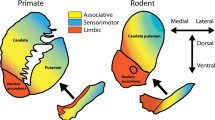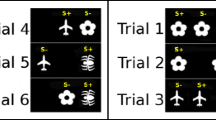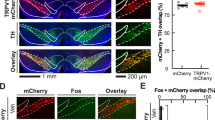Abstract
In the early 90s, we studied the role of perception disturbances in schizophrenia in our first clinical approaches, using the Bender test in schizophrenic patients. Results were clear, showing a shape discrimination failure. Following this initial results, we reproduced nuclear symptoms of schizophrenia in animal models, showing that perceptual disturbances, acquisition disturbances, decrease in affective levels and working memory disturbances can be induced by specific N-methyl-d-aspartic acid (NMDA) glutamatergic blockade within the nucleus accumbens septi (NAS). We studied also another glutamatergic and dopaminergic drugs, finding that a decrease in glutamatergic transmission within NAS led to cognitive disturbances and affective flattening. An increase in glutamatergic transmission fully enhances cognition in the tasks used. Dopaminergic D-2 antagonists partially improved cognition. Our results link the proposed corticostriatal dysfunction with the thalamocortical disturbances underlying perceptual problems, but also influencing affective levels and cognitive variables. According to our translational findings, core schizophrenia symptoms may be translationally reproduced antagonizing NMDA receptors within NAS, and improved blocking the glutamate auto-receptor. Dopaminergic transmission appears to have a role in therapeutic but not in the early pathophysiology of schizophrenia.
Similar content being viewed by others
References
Amitai N, Markou A. Disruption of performance in the five-choice serial reaction time task induced by administration of N-methyl-D-aspartate receptor antagonists: relevance to cognitive dysfunction in schizophrenia. Biol Psychiatry 2010;68:5–16.
Matthysse S. Making animal models relevant to psychiatry. Ann NY Acad Sci 1983;406:133–9.
McKinney Jr WT. Animal models in psychiatry. Perspect Biol Med 1974;17:529–42.
McKinney WT, Moran EC. Animal models of schizophrenia. Am J Psychiatry 1981;138:478–83.
Kaffman A, Krystal JH. New frontiers in animal research of psychiatric illness. Methods Mol Biol 2012;829:3–30.
Machado-Vieira R. Tracking the impact of translational research in psychiatry: state of the art and perspectives. J Transl Med 2012;10:175.
Gargiulo PA, Viana MB, Graeff FG, Silva MA, Tomaz C. Effects of anxiety and memory of systemic and intra-amygdala injection of 5-HT3 receptor antagonist BRL 46470A. Neuropsychobiology 1996;33:189–95.
Gargiulo PA, Donoso AO. Distinct grooming patterns induced by intracerebroventricular injection of CRH, TRH and LHRH in male rats. Braz J Med Biol Res 1996;29:375–9.
Grace AA. Gating of information flow within the limbic system and the pathophysiology of schizophrenia. Brain Res Rev 2000;31:330–41; Graeff FG, Zangrossi Jr H. The dual role of serotonin in defense and the mode of action of antidepressants on generalized anxiety and panic disorders. Cent Nerv Syst Agents Med Chem 2010;10:207–17.
Haller J, Alicki M. Current animal models of anxiety, anxiety disorders, and anxiolytic drugs. Curr Opin Psychiatry 2012;25:59–64.
Camplesi Jr M, de Bortoli VC, de Paula Soares V, Nogueira RL, Zangrossi Jr H. Dorsal periaqueductal gray stimulation facilitates anxiety-, but not panic-related, defensive responses in rats tested in the elevated T-maze. Braz J Med Biol Res 2012;45:1025–30.
Roncon CM, Biesdorf C, Santana RG, Zangrossi Jr H, Graeff FG, Audi EA. The panicolytic-like effect of fluoxetine in the elevated T-maze is mediated by serotonin-induced activation of endogenous opioids in the dorsal periaqueductal grey. J Psychopharmacol 2012;26:525–31.
Berton O, Hahn CG, Thase ME. Are we getting closer to valid translational models for major depression? Science 2012;338:75–9.
Dzirasa K, Covington III HE. Increasing the validity of experimental models for depression. Ann NY Acad Sci 2012;1265:36–45.
Young JW, Henry BL, Geyer MA. Predictive animal models of mania: hits, misses and future directions. Br J Pharmacol 2011;164:1263–84.
Geyer MA. Develo** translational animal models for symptoms of schizophrenia or bipolar mania. Neurotox Res 2008;14:71–8.
Baune BT, Thome J. Translational research approach to biological and modifiable risk factors of psychosis and affective disorders. World J Biol Psychiatry 2011;12(Suppl. 1):28–34.
Halberstadt AL, Geyer MA. Multiple receptors contribute to the behavioral effects of indoleamine hallucinogens. Neuropharmacology 2011;61:364–81.
Hanks JB, González-Maeso J. Animal models of serotonergic psychedelics. ACS Chem Neurosci 2013;4:33–42.
Jones CA, Watson DJ, Fone KC. Animal models of schizophrenia. Br J Pharmacol 2011;164:1162–94.
Gargiulo PA. Popper and psychopathology: some possible implications of his thought. In: Gargiulo PA, editor. On hopelessness and other psychological studies. Germany: Editorial Académica Espańola, AV Akademiker Verlag Gmbh & Co. K.G. Saarbrücken; 2012 (Spanish).
Huber G. The psychopathology of K. Jaspers and K. Schneider as a fundamental method for psychiatry. World J Biol Psychiatry 2002;3:50–7.
Tandon R, Nasrallah HA, Keshavan MS. Schizophrenia, ‘‘just the facts’’ 5. Treatment and prevention. Past, present, and future. Schizophr Res 2010;122:1–23.
Feldon J, Weiner I. From an animal model of an attentional deficit towards new insights into the pathophysiology of schizophrenia. J Psychiatr Res 1992;26:345–66.
Grace AA. Cortical regulation of subcortical dopamine systems and its possible relevance to schizophrenia. J Neural Transm Gen Sect 1993;91:111–34.
Gray JA. Integrating schizophrenia. Schizophr Bull 1998;24:249–66.
Matthysse S. Schizophrenia: relationship to dopamine transmission, motor control and feature extraction. In: The neurosciences: third study program. Cambridge, MA: MIT Press; 1974. p. 733–7.
Matthysse S. Nucleus accumbens and schizophrenia. In: Chronister RB, De France JF, editors. The neurobiology of the nucleus accumbens, Sebasco Estaes. 1980. p. 351–9. Haer Institute. Proceedings of the symposium: nucleus acumbens, Sebasco Estaes, Maine, 1980.
O’Donnell P, Grace AA. Dysfunctions in multiple interrelated systems as the neurobiological bases of schizophrenic symptom clusters. Schizophr Bull 1998;24:267–83.
Matthysse S. Antipsychotic drug actions: a clue to neuropathology of schizophrenia? Fed Proc 1973;32:200–5.
Schneider K. Clinical psychopathology.(Hamilton M.W., Trans.) New York: Grune and Stratton; 1959.
Crow TJ. Molecular pathology of schizophrenia: more than one disease process? Br Med J 1980;280:66–8.
Crow TJ. The two-syndrome concept: origins and current status. Schizophr Bull 1985;11:471–86.
Reichenberg A, Harvey PD, Bowie CR, Mojtabai R, Rabinowitz J, Heaton RK, et al. Neuropsychological function and dysfunction in schizophrenia and psychotic affective disorders. Schizophr Bull 2009;35:1022–9.
Acerbo MJ, Gargiulo PA, Krug I, Delius JD. Behavioural consequences of nucleus accumbens dopaminergic stimulation and glutamatergic blocking in pigeons. Behav Brain Res 2002;136:171–7.
Conrad K. Die beginnende Schizophrenie. Versuch einer Gestaltanalyse des Wahnsinns. Incipient schizophrenia: an attempt at a gestaltic analysis of insanity Stuttgart: Thieme; 1966.
Costello CG. Symptoms of schizophrenia. New York, NY: Wiley; 1993.
Gargiulo PA, Siemann M, Delius JD. Visual discrimination in pigeons impaired by glutamatergic blockade of nucleus accumbens. Physiol Behav 1998;63: 705–9.
Gargiulo PA, Acerbo MJ, Krug I, Delius JD. Cognitive effects of dopaminergic and glutamatergic blockade in nucleus accumbens in pigeons. Pharmacol Biochem Behav 2005;81:732–9.
Martínez G, Ropero C, Funes A, Flores E, Blotta C, Landa AI, et al. Effects of NMDA and non-NMDA blockade in the nucleus accumbens on the plus maze test. Physiol Behav 2002;76:219–24.
Martínez G, Ropero C, Funes A, Flores E, Landa AI, Gargiulo PA. AP-7 into the nucleus accumbens disrupts acquisition but does not affect consolidation in a passive avoidance task. Physiol Behav 2002;76:205–12.
Baiardi G, Ruiz AM, Beling A, Borgonovo J, Martinez G, Landa AI, et al. Glutamatergic ionotropic blockade within accumbens disrupts working memory and might alter the endocytic machinery in rat accumbens and prefrontal cortex. J Neural Transm 2007;114:1519–28.
Gargiulo PA, Landa de Gargiulo AI. Perception and psychoses: the role of glutamatergic transmission within tne nucleus Accumbens Septi. Behav Brain Sci 2004;27:792–3.
Del Vecchio S, Gargiulo PA. Visual and motor function in schizophrenic patients. Acta Psiquiatr Psicol Am Lat 1992;38:317–22.
Gargiulo PA, Del Vecchio S. Gestaltic visual motor function in schizophrenic patients. Göttingen Neurobiology Report 1997. In: Elsner N, Wässle H, editors. Proceedings of the 25th Göttingen neurobiology conference 1997, Vol. II, Communication 1005. Stuttgart: Thieme; 1997.
Gargiulo PA. Aproximaciones Experimentales a la Percepción Delirante Experimental approaches to delusional perception Alcmeón Rev Argent Neuropsiquiatr 2001;37:18–30.
Gargiulo PA. Aproximaciones Experimentales al a Disfunción perceptual en la Esquizofrenia Experimental approaches to perceptual dysfunction in schizophrenia Rev Neurol (Spain) 2003;6:545–51.
Holden C. Deconstructing schizophrenia. Science 2003;299:333–5.
Yoon JH, Sheremata SL, Rokem A, Silver MA. Windows to the soul: vision science as a tool for studying biological mechanisms of information processing deficits in schizophrenia. Front Psychol 2013;4:681.
Matussek P. Untersuchungen über die Wahnwahrnehmungen Studies on the delusional perceptions, German Arch Psychiatr Nervenkr 1952;189:279–318.
Kleinman JE, Gillin JC, Wyatt RJ. A comparison of the phenomenology of hallucinogens and schizophrenia from some autobiographical accounts. Schizophr Bull 1977;3:560–86.
Green MF, Nuechterlein KH, Breitmeyer B, Mintz J. Backward masking in unmedicated schizophrenic patients in psychotic remission: possible reflection of aberrant cortical oscillation. Am J Psychiat 1999;156:1367–73.
Delius JD, Hollard VD. Orientation invariant pattern recognition by pigeons (Columba livia) and humans (Homo sapiens). J Comp Psychol 1995;109:278–90.
Aleman A, Kahn RS. Strange feelings: do amygdala abnormalities dysregulate the emotional brain in schizophrenia? Prog Neurobiol 2005;77:283–98.
Llano Lopez L, Caif F, Fraile M, Tinnirello B, Landa A, Lafuente JV, et al. Differential behavioral profile induced by the injection of dipotassium chlorazepate within brain areas that project to the nucleus accumbens septi. Pharmacol Rep 2013;65:566–78.
Gargiulo PA, Martinez G, Ropero C, Funes A, Landa AI. NMDA glutamatergic blockade of nucleus accumbens disrupts acquisition but not consolidation in a passive avoidance task. Ann NY Acad Sci 1999;877:717–22.
Carlsson A, Waters N, Waters S, Carlsson ML. Network interactions in schizophrenia-therapeutic implications. Brain Res Brain Res Rev 2000;31: 342–9.
Kelley AE, Andrzejewski ME, Baldwin AE, Hernandez PJ, Pratt WE. Glutamate-mediated plasticity in corticostriatal networks. Role in adaptive motor learning. Ann NY Acad Sci 2003;1003:159–68.
Sesack SR, Pickel VM. In the rat medial nucleus accumbens, hippocampal and catecholaminergic terminals converge on spiny neurons and are in apposition to each other. Brain Res 1990;527:266–79.
Mogenson GJ, Yang CR, Yim CY. Influence of dopamine on limbic inputs to the nucleus accumbens. Ann NY Acad Sci 1988;537:86–100.
O’Donnell P, Grace AA. Tonic D2-mediated attenuation of cortical excitation in nucleus accumbens neurons recorded in vitro. Brain Res 1994;634: 105–12.
O’Donnell P, Grace AA. Dopaminergic reduction of excitability in nucleus accumbens neurons recorded in vitro. Neuropsychopharmacology 1996;15: 87–97.
Pennartz CMA, Dollerman-van der Weel MJ, Kitai ST, Lopes da Silva FH. Presynaptic dopamine D1 receptors attenuate excitatory and inhibitory limbic inputs to the shell region of the rat nucleus accumbens. J Neurophysiol 1992;1325–34.
Yim CY, Mogenson GJ. Mesolimbic dopamine projection modulates amygdala-evoked EPSP in nucleus accumbens neurons: an in vivo study. Brain Res 1986;369:347–52.
Richfield EK, Penney JB, Young AB. Anatomical and affinity state comparisons between dopamine D1 and D2 receptors in the rat central nervous system. Neuroscience 1989;30:767–77.
Grace AA. The depolarization block hypothesis of neuroleptic action: implications for the etiology and treatment of schizophrenia. J Neural Transm Suppl 1992;36:91–131.
Valenti O, Grace AA. Antipsychotic drug-induced increases in ventral tegmental area dopamine neuron population activity via activation of the nucleus accumbens-ventral pallidum pathway. Int J Neuropsychopharmacol 2010;13:845–60.
Grace AA, Bunney BS, Moore H, Todd CL. Dopamine-cell depolarization block as a model for the therapeutic actions of antipsychotic drugs. Trends Neurosci 1997;20:31–7.
Valenti O, Cifelli P, Gill KM, Grace AA. Antipsychotic drugs rapidly induce dopamine neuron depolarization block in a developmental rat model of schizophrenia. J Neurosci 2011;31:12330–38.
Holden C. Excited by glutamate. Science 2003;300:1866–8.
Moghaddam B, Javitt D. From revolution to evolution: the glutamate hypothesis of schizophrenia and its implication for treatment. Neuropsychopharmacology 2012;37:4–15.
Noetzel MJ, Jones CK, Conn PJ. Emerging approaches for treatment of schizophrenia: modulation of glutamatergic signaling. Discov Med 2012;14:335–43.
Onitsuka T, Oribe N, Nakamura I, Kanba S. Review of neurophysiological findings in patients with schizophrenia. Psychiatry Clin Neurosci 2013;67: 461–70.
Palmer BW, Dawes SE, Heaton RK. What do we know about neuropsychological aspects of schizophrenia? Neuropsychol Rev 2009;19:365–84.
Rao NP. Pathogenetic and therapeutic perspectives on neurocognitive models in psychiatry: a synthesis of behavioral, brain imaging, and biological studies. Indian J Psychiatry 2012;54:217–22.
Darke H, Peterman JS, Park S, Sundram S, Carter O. Are patients with schizophrenia impaired in processing non-emotional features of human faces? Front Psychol 2013;4:529.
Giersch A, Lalanne L, van Assche M, Elliott MA. On disturbed time continuity in schizophrenia: an elementary impairment in visual perception? Front Psychol 2013;4:281.
Volman SF, Lammel S, Margolis EB, Kim Y, Richard JM, Roitman MF, et al. New insights into the specificity and plasticity of reward and aversion encoding in the mesolimbic system. J Neurosci 2013;33:17569–76.
Carlsson M, Carlsson A. The NMDA antagonist MK-801 causes marked locomotor stimulation in monoamine-depleted mice. J Neural Transm 1989;75:221–6.
Kantrowitz JT, Javitt DC. Thinking glutamatergically: changing concepts of schizophrenia based upon changing neurochemical models. Clin Schizophr Relat Psychoses 2010;4:189–200.
Snyder MA, Gao WJ. NMDA hypofunction as a convergence point for progression and symptoms of schizophrenia. Front Cell Neurosci 2013;7:31.
Rao VS, Carvalho AC, Trevisan MT, Andrade GM, Nobre-Júnior HV, Moraes MO, et al. Mangiferin ameliorates 6-hydroxydopamine-induced cytotoxicity and oxidative stress in ketamine model of schizophrenia. Pharmacol Rep 2012;64:848–56.
Rogóż Z. Effect of co-treatment with mirtazapine and risperidone in animal models of the positive symptoms of schizophrenia in mice. Pharmacol Rep 2012;64:1567–72.
Wędzony K, Fijał K, Maćkowiak M, Chocyk A. Detrimental effect of postnatal blockade of N-methyl-D-aspartate receptors on sensorimotor gating is reversed by neuroleptic drugs. Pharmacol Rep 2008;60:856–64.
Wędzony K, Markowicz-Kula K, Chocyk A, Fijał K, Przyborowska A, Maćkowiak M. Impact of postnatal dexamethasone on psychotomimetic effects of MK-801 measured on adult rats. Pharmacol Rep 2009;61:1034–41.
Keshavan MS, Kaneko Y. Secondary psychoses: an update. World Psychiatry 2013;12:4–15.
Rompala GR, Zsiros V, Zhang S, Kolata SM, Nakazawa K. Contribution of NMDA receptor hypofunction in prefrontal and cortical excitatory neurons to schizophrenia-like phenotypes. PLoS ONE 2013;8(4):e61278.
Sacchetti E, Scassellati C, Minelli A, Valsecchi P, Bonvicini C, Pasqualetti P, et al. Schizophrenia susceptibility and NMDA-receptor mediated signalling: an association study involving 32 tagSNPs of DAO, DAOA, PPP3CC, and DTNBP1 genes. BMC Med Genet 2013;14:33.
Timms AE, Dorschner MO, Wechsler J, Choi KY, Kirkwood R, Girirajan S, et al. Support for the N-methyl-D-aspartate receptor hypofunction hypothesis of schizophrenia from exome sequencing in multiplex families. JAMA Psychiatry 2013;70:582–90.
Schwartz TL, Sachdeva S, Stahl SM. Genetic data supporting the NMDA glutamate receptor hypothesis for schizophrenia. Curr Pharm Des 2012;18: 1580–92.
Javitt DC. Glycine transport inhibitors in the treatment of schizophrenia. Handb Exp Pharmacol 2012;213:367–99.
Javitt DC, Zukin SR, Heresco-Levy U, Umbricht D. Has an angel shown the way? Etiological and therapeutic implications of the PCP/NMDA model of schizophrenia. Schizophr Bull 2012;38:958–66.
Moghaddam B, Adams BW. Reversal of phencyclidine effects by a group II metabotropic glutamate receptor agonist in rats. Science 1998;281:1349–52.
File SE. Sedative effects of PK 9084 and PK 8165, alone and in combination with chlordiazepoxide. Br J Pharmacol 1983;79:219–23.
Schwartz TL, Sachdeva S, Stahl SM. Glutamate neurocircuitry: theoretical underpinnings in schizophrenia. Front Pharmacol 2012;3:195.
Patil ST, Zhang L, Martenyi F, Lowe SL, Jackson KA, Andreev BV, et al. Activation of mGlu2/3 receptors as a new approach to treat schizophrenia: a randomized Phase 2 clinical trial. Nat Med 2007;13:1102–7.
Sumiyoshi T, Higuchi Y, Uehara T. Neural basis for the ability of atypical antipsychotic drugs to improve cognition in schizophrenia. Front Behav Neurosci 2013;7:140.
Khorana AB, Patel Y. Comparative short-term evaluation of penfluridol and trifluoperazine in chronic schizophrenia. Indian J Physiol Pharmacol 1988;32:293–8.
Marques LO, Lima MS, Soares BG. Trifluoperazine for schizophrenia. Cochrane Database Syst Rev 2004;CD003545.
Donnelly L, Rathbone J, Adams CE. Haloperidol dose for the acute phase of schizophrenia. Cochrane Database Syst Rev 2013;8:CD001951.
Marder SR. Limitations of dopamine-D2 antagonists and the search for novel antipsychotic strategies. Neuropharmacology 1999;21:S117–21.
Meltzer HY, Arvanitis L, Bauer D, Rein W, Meta-Trial Study Group. Placebo-controlled evaluation of four novel compounds for the treatment of schizophrenia and schizoaffective disorder. Am J Psychiatry 2004;161: 975–84.
Kinon BJ, Zhang L, Millen BA, Osuntokun OO, Williams JE, Kollack-Walker S, et al. A multicenter, inpatient, phase 2, double-blind, placebo-controlled dose-ranging study of LY2140023 monohydrate in patients with DSM-IV schizophrenia. J Clin Psychopharmacol 2011;31:349–55.
Moghaddam B, Krystal JH. Capturing the angel in ‘‘angel dust’’: twenty years of translational neuroscience studies of NMDA receptor antagonists in animals and humans. Schizophr Bull 2012;38:942–9.
Krystal JH, Sanacora G, Duman RS. Rapid-acting glutamatergic antidepressants: the path to ketamine and beyond. Biol Psychiatry 2013;73:1133– 41.
Robson MJ, Elliott M, Seminerio MJ, Matsumoto RR. Evaluation of sigma (σ) receptors in the antidepressant-like effects of ketamine in vitro and in vivo. Eur Neuropsychopharmacol 2012;22:308–17.
Poels EM, Kegeles LS, Kantrowitz JT, Slifstein M, Javitt DC, Lieberman JA, et al. Imaging glutamate in schizophrenia: review of findings and implications for drug discovery. Mol Psychiatry 2013. http://dx.doi.org/10.1038/mp.2013.136.
Author information
Authors and Affiliations
Corresponding author
Rights and permissions
About this article
Cite this article
Gargiulo, P.Á., De Gargiulo, A.I.L. Glutamate and modeling of schizophrenia symptoms: Review of our Findings: 1990–2014. Pharmacol. Rep 66, 343–352 (2014). https://doi.org/10.1016/j.pharep.2014.03.010
Received:
Revised:
Accepted:
Published:
Issue Date:
DOI: https://doi.org/10.1016/j.pharep.2014.03.010




